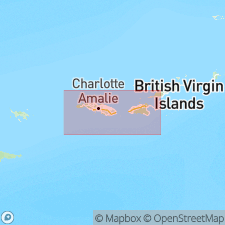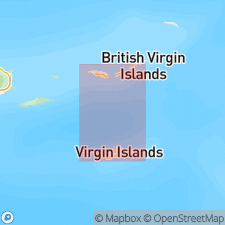
- Usage in publication:
-
- Outer Brass Limestone
- Modifications:
-
- Overview
- Dominant lithology:
-
- Limestone
- Tuff
- AAPG geologic province:
-
- Caribbean region
Summary:
Outer Brass Limestone consists of mainly thin-bedded, siliceous limestone with small admixture of tuff. Type locality is on Outer Brass Island where it is completely exposed along a sea cliff on western side of island, offshore northern St. Thomas, VI. Occurs in a narrow band extending from Outer Brass Island, onshore at Mogens Bay and southeast to Footer Point. Underlies valley at Lovenlund. Contains poorly exposed Radiolaria, some of which are same as those in Water Island Formation. ?GLOBOGERINELLA sp. and sponge spicules were also reported by P. Bronnimann (personal comm.), as well as several echinoderm plates near Freyendal, St. Thomas. Thickness is 600 ft at type locality. Overlies Louisenhoj Formation; underlies Tutu Formation. Age is Late Cretaceous.
Source: GNU records (USGS DDS-6; Reston GNULEX).

- Usage in publication:
-
- Outer Brass Limestone*
- Modifications:
-
- Overview
- AAPG geologic province:
-
- Caribbean region
Summary:
Author follows usage of Donnelly (1959, 1966) for the rocks on St. Thomas and St. John, VI. They include (ascending) the Early Cretaceous Water Island Formation and the Late Cretaceous Louisenhoj Formation, Outer Brass Limestone, Tutu Formation (with its informal Coki Point Megabreccia lithofacies and Congo Cay Limestone Member of Donnelly, 1959), and Hans Lollik Formation. Five felsic rocks from Water Island Formation, dated by Michael Diggles (U.S. Geological Survey) using K-Ar whole rock techniques, yielded a range from 65.8+/-2.9 to 30.9+/-0.3 Ma. Two rocks from Louisenhoj Formation also were dated using K-Ar techniques by Diggles and yielded a range from 42.1+/-0.6 to 37.7+/-1.1 Ma.
Source: GNU records (USGS DDS-6; Reston GNULEX).
For more information, please contact Nancy Stamm, Geologic Names Committee Secretary.
Asterisk (*) indicates published by U.S. Geological Survey authors.
"No current usage" (†) implies that a name has been abandoned or has fallen into disuse. Former usage and, if known, replacement name given in parentheses ( ).
Slash (/) indicates name conflicts with nomenclatural guidelines (CSN, 1933; ACSN, 1961, 1970; NACSN, 1983, 2005, 2021). May be explained within brackets ([ ]).

